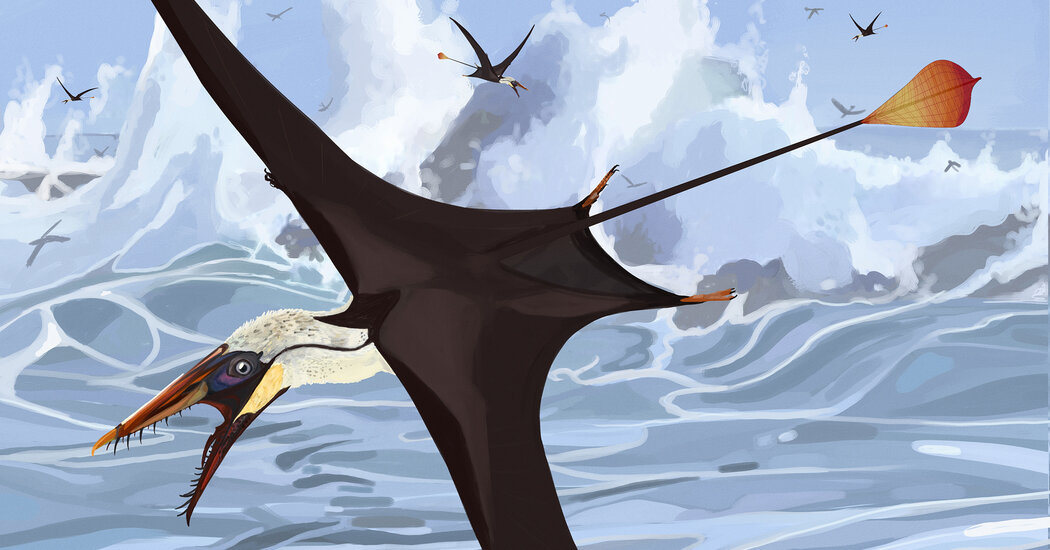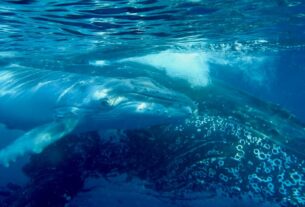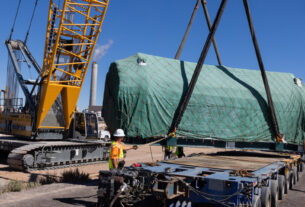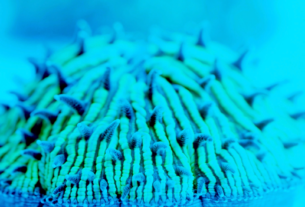Above the shores of prehistoric seas and lakes, pterosaurs roamed the skies. They were feathered creatures that ranged in size from pigeons to planes, and the first vertebrates known to have been able to fly. And for millions of years, they had long tails ending in a prominent flap of skin called a vane.
Paleontologists have long wondered about this strange appendage and its purpose. A team of scientists using a laser scanning technology have found new structures in four pterosaur fossils that helped keep the vane stiff, suggesting it aided maneuvering in flight.
The study, published in December in the journal eLife, shows that “even fossils that we knew and studied in detail for hundreds of years might have new things to show if you develop new technology to see them,” said Natalia Jagielska, a paleontologist at the Lyme Regis Museum in England and the paper’s lead author.
Dr. Jagielska, also a professional artist, became involved in the research after Michael Pittman, a paleontologist at the Chinese University of Hong Kong, approached her about illustrating a children’s book. They teamed up to examine pterosaur fossils in collections in England and Scotland.
After surveying over 100 pterosaur specimens, scientists picked four from the species Rhamphorhynchus, which often had diamond-shaped, kitelike tail vanes, for follow-up with laser-stimulated fluorescence. Dr. Pittman and Thomas G. Kaye, director of the Foundation for Scientific Advancement and an author of the study, have promoted the technique for exploring dinosaur-era remains and for archaeological investigations.
The laser method makes use of how some minerals glow when electrons absorb and then re-emit light. As a laser passes over the fossils, long-exposure digital photography captures hidden features that stand out
Pictures from the first pterosaur specimen they scanned showed a lattice structure in the tail vane. For Dr. Pittman, this was “a ta-da moment.”
“It looks like the kind of crisscross on a waffle fry,” he said. “But that structure in engineering is a reinforcing structure.”
The “struts” of this lattice could have been beneficial to flight, Dr. Jagielska said. They would “tense up when you have a gust of air, similar to a sail in a ship, and that probably reduces the flutter” and might have helped the pterosaur in “making turns,” she said.
Scientists say the primary function for the vane still could have been social display, like a peacock’s tail feathers are a signal to attract mates. In that vein, the vane most likely had prominent colors and patterns that are not preserved in the fossil record, Dr. Pittman said.
Even so, like a modern billboard, the “display surface” needed support structures, which this study reveals in pterosaurs for the first time, Dr. Pittman said. Had the vane fluttered unfettered, it would have been “extremely costly and simultaneously useless as a visual signal,” said Michael Habib, a pterosaur flight expert at the University of California, Los Angeles, and an author of the study.
The result is a significant advancement in the study of pterosaurs, said Andrea Cau, a paleontologist in Italy who was not involved in the study. He noted that one of the pterosaur fossils had not shown any soft-tissue details using other techniques but that the laser fluorescence had brought them out.
“Given the rarity of soft-tissue remains in paleontology, even just a single new fossil makes the difference,” he said.
Future studies of pterosaur tails may illuminate “just how good was this structure as a rudder or as a stabilizer,” said Scott Persons, a paleontologist at the College of Charleston in South Carolina who was not involved in this study. Given that different pterosaurs had differently sized vanes, more research may also show whether that variation had to do more with optimizing flight or “fashion.”
Dr. Jagielska would like to explore why the long tails with vanes disappeared in pterosaurs by the start of the Cretaceous period, about 146 million years ago. Further laser scanning may also bring out other characteristics important to pterosaur flight. A better understanding of their anatomy could even inspire airborne vehicles someday.
“If they were so efficient that they could live for hundreds of millions of years, they probably are doing something right,” Dr. Jagielska said.





